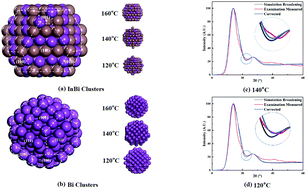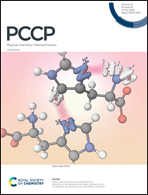Theoretical and experimental study of the microstructure of a metallic melt in an In50Bi50 alloy based on the Wulff cluster model†
Abstract
In this paper, the Wulff cluster model which has been proved to successfully describe the melt structure of pure metals, homogenous alloys and eutectic alloys has been extended to an alloy with intermetallic compounds (In50Bi50). According to the cohesive energy and the solid-state XRD patterns, the most possible types of clusters in the melt are Bi and InBi. At relatively high temperatures, the superimposed XRD (simulated) patterns of Bi and InBi clusters are in good agreement with the experimental HTXRD patterns in terms of the position and intensity of the peaks. With the decrease of temperature, there is an obvious deviation in the simulated XRD value at the second peak caused by the nucleation process of Bi clusters, which would be modified by adding simulated XRD patterns of the Bi bulk. The proportion of the superimposed Bi bulk XRD pattern increases with the decrease of temperature suggesting that the nucleation process of the Bi cluster begins at 160 °C.

- This article is part of the themed collection: 2022 PCCP HOT Articles


 Please wait while we load your content...
Please wait while we load your content...